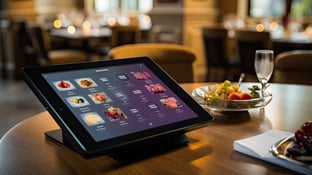Your POS (point of sale) system should be the cornerstone of your restaurant tech stack. Of course, if you don't know what a “tech stack” is, that probably doesn’t mean a whole lot to you. So let’s start there.
What is a Restaurant Tech Stack?
Basically, your tech stack is all the technology you use to run your restaurant. A restaurant tech stack may include your online ordering platform, inventory management software, digital marketing tools, labor management solutions, and more.
In the past, building a good tech stack meant signing up and paying for a lot of different services. But today, restaurant POS systems are built to do all of these things and more. The new generation of POS systems comes with a ton of capabilities like accepting payments, streamlining labor management, promoting more personalized customer experiences, and more.
The move toward all-in-one, cloud-based solutions now makes it possible to build your entire restaurant tech stack around a single POS system.
What Do We Mean by an All-in-One, Cloud-Based POS System?
A cloud-based POS system uses the internet to store and access data. This data is located in a remote computer server, which is provided by your POS vendor. In the past, most restaurants used a server-based POS system. This means that your data was stored on a computer located in your restaurant.
Cloud-based POS systems are considered a major upgrade because they are more secure, remotely accessible, and easier to update in real time. In spite of these advantages, POS provider SpotOn has reported that 81% of independent and small chain restaurant owners were still using traditional, server-based POS systems. It seems many restaurants are hesitant to make the leap.
But with the right restaurant POS system, that leap could be a true game changer for your business. We wanted to learn more, so we caught up with Scott Youkilis, Restaurateur in Residence for industry-leading POS provider SpotOn.
The Evolution of Restaurant Technology
Before joining SpotOn in 2021, Scott was the head chef and owner for a number of San Francisco area restaurants. Youkilis remembers that when he first jumped into the restaurant business, it was quite a different landscape.
“There was no Facebook. No Yelp! There was no social media. There were no cloud-based systems,” he recalls.
But over the last two decades, restaurant technology has evolved dramatically. And with each new development, Youkilis saw the opportunity to spend more time doing what he loved.
“I was always wanting to find the next best tool, to be more efficient, to find myself doing the things I wanted to do, like cooking, running a restaurant, being with guests, and making drinks — doing all the fun stuff, right?”
Today, with SpotOn, Youkilis is helping other restaurant owners, operators, and chefs seize the same opportunity – to focus on the fun stuff.
6 Things We Learned About POS Systems and Your Restaurant Tech Stack
SpotOn is an industry-leading, all-in-one, cloud-based POS platform that can be customized to every type of restaurant operation. We asked Scott about the role of a restaurant POS system in your overall tech stack.
Here’s what we learned.
1. Advanced Restaurant POS Systems Are Becoming More Affordable
At a time when restaurants are grappling with the rising costs of food and labor, restaurant POS systems are the rare example of something that’s becoming more affordable. Youkilis explains that a number of developments have helped to lower the price.
First, he notes, the move from server-based systems to cloud-based systems means you don’t have to invest in expensive hardware to power your POS system. Second, Youkilis highlights the move toward all-in-one POS systems.
He explains, “The cost is much lower now that we have everything in an all-in-one system where I can process POS and online ordering, access a labor management solution, take reservations, and on and on and on.”
This affordability and all-inclusiveness means that even a small independent business can begin building out an advanced restaurant tech stack with the right POS system.
2. POS Systems Can Help Protect Profit Margins in Uncertain Times
With food costs rising, immigration policies shaking up the labor landscape, and customers becoming increasingly wary about where they spend their money, restaurant owners face tremendous uncertainty and shrinking profit margins. Youkilis warns that these challenges aren’t going away any time soon.
“I think that the world has become much more complicated for restaurants… and the costs of labor and goods are not going down. They're only going to continue to rise.”
The pressure is on restaurant owners to offset these costs and uncertainties with greater efficiency. The right POS system can unlock new efficiencies for your restaurant by helping you see where you’re spending too much time each week, whether it’s on payroll management, staff scheduling, or answering phones.
With the right technology, says Youkilis, “you’re going to find those inefficiencies, and you’re going to spot the data points that can help you find more margin.”

Download the Free POS Guide
Find the best POS system for your restaurant with this expert-vetted guide.
*Submitting this form will also subscribe you to our weekly newsletter. Unsubscribe at any time.
3. Your POS System Must Be Customizable Based on Your Restaurant’s Needs
The POS system is essentially the central nervous system of your restaurant tech stack. That means it must be built with your business in mind. In order for a POS system to truly drive greater efficiency, it must be tailored to your needs.
While a lot of restaurant POS systems boast all-in-one capabilities, this isn’t necessarily the same as offering customized solutions. Youkilis explains that providers like SpotOn “develop the system and deliver the solutions that work the way your restaurant works.
“What that means for building a tech stack is that we can provide an all-in-one platform and customize it to make sure it’s going to work specifically for your restaurant.”
4. Integrations Are Essential When Implementing a Restaurant POS System
All-in-one POS systems can handle a lot of functions, but you may still need additional third-party technology. This is where integrations become vital. For instance, Youkilis notes, you may need to look beyond your POS system for functions like inventory management, invoice management, or AI-powered data analysis.
In order for your POS system to serve as the cornerstone for your restaurant tech stack, it must provide a full range of integrations. In short, you want to choose a restaurant POS system that is compatible with the technology you’re already using, and is also flexible enough to integrate with new innovations that you may want to add later.
Youkilis notes that strong industry relationships are an important part of the equation.
“We rely on other companies that are specifically building those kinds of software solutions,” he says, “and we create great partnerships so that when people want to add on, we can actually bring that together.”
5. Your POS System Can Drive Labor Management Improvements
SpotOn’s all-in-one POS system also includes a labor-management tool called SpotOn Teamwork that streamlines payroll, scheduling, and more.
“It's a game changer,” says Youkilis. “I was talking to a client today who was like, ‘I've saved five to six hours every time I do payroll because of SpotOn.’”
But it’s about more than just payroll management and scheduling. As a resident of California, Youkilis has seen firsthand how statewide labor laws can add complexity to payroll management and tip distribution.
The right POS system can not only reduce the time spent navigating these complexities, but it can also help ensure your compliance with the specific rules of your state. This, of course, can spare you a fortune in legal costs and fines for non-compliance.
6. Human Support Is Important, Even With The Best Restaurant POS Systems
If you plan to build your tech stack around an all-in-one restaurant POS system, be sure you have the support to do it right. Even with the best restaurant POS system, you will experience some growing pains.
“If you’ve been working with some old system for 20 years, yeah, it's going to be a change for everyone,” warns Youkilis.
That’s why it’s so important to choose a partner with outstanding customer service. Youkilis explains that “you're going to need actual humans, a team to help you along the way, to get you to the next stage quickly. You’ll need support from dedicated people – 365, 24/7.”
Updating Your Restaurant Tech Stack With the Right POS System
We learned one other very important fact in our conversation with Scott Youkilis. If your restaurant is still operating on an old POS system, now is the time to make a change.
“Independent and family restaurants can't run like they used to. You have to be a little more corporate…You have to have good handbooks, keep things really buttoned up. Because if you don't… you're going to lose money. I think the small guys should try to emulate the big guys as much as possible. And luckily, now the tools are actually affordable.”
Still not sure which tools are right for your restaurant tech stack? That’s why we’re here! Reach out for a consultation, tell us what you’re looking for, and we’ll get you hooked up with the best restaurant POS system for your business!





